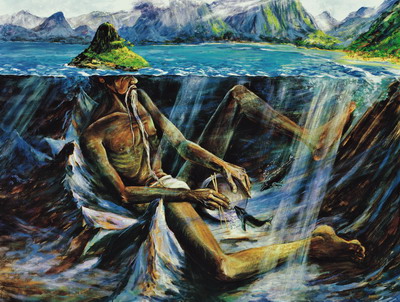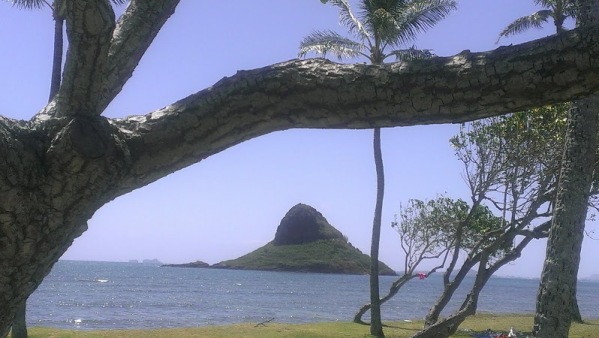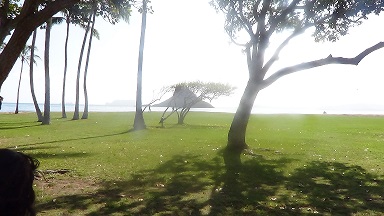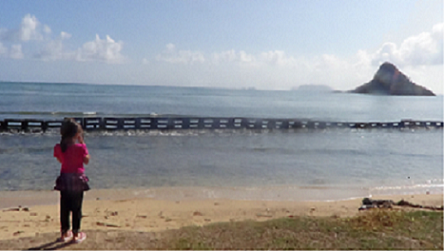The Legendary Chinaman's Hat
Trips around the island to see Chinaman's Hat is part of of my Hawaiian legacy
By M. Keala Milles, Jr.
The first
time I saw Chinaman's Hat was actually as fantastically depicted in the
painting by artist Dean Howell. His 1983 painting—now valued at $60,000 (with reprints available for as much as $300)—takes you under the
sea where Howell reveals a giant Chinese man resting on the ocean floor, the
island as his hat.

Dean Howell's painting of Chinaman's Hat
(hung in my parents home in Washington)
Photo by M. Keala Milles, Jr.
Of course, this is
just an artistic interpretation, but seeing the small, uninhabited island in
person—especially as a child—I wondered if such things could be true. Having heard many other larger-than-life Hawaiian legends from my parents, I felt that surely there must be some
truth to this fable.

Nice view of Chinaman's Hat
Photo by M. Keala Milles, Jr.
Legend of Mokoli'i
The story of Chinaman's Hat or its Hawaiian name, Mokoli'i, had nothing to do with a Chinese man or his hat, but a lizard and his back. As I have come to understand it, this story tells of the time Pele’s sister, Hi'iaka, slew a giant lizard and threw its tail into the ocean, just off the wayward shore. The island of Mokoli'i remains a remnant of the lizard’s back, poking through the water.
Even though I only recently learned of this story, the imagery takes me back to when I was twelve years old and first heard the legend of Hanauma Bay--which also refers to lizards--and never saw that bay the same way again.
View Larger Map
The Windward's Landmark
When you encounter the island in real life, though, it is still nearly as fantastical as its Hawaiian legends might lend. Located on the Windward side of Oahu, just North of Kaneohe, the tiny basalt islet of Mokoli'i is easily visible from the main shore, particularly from the Kualoa mountain range.
In fact, at only 1,477 feet from Kualoa park, it is so close that you could walk there quickly when the tide is low enough. Most adventurers paddle a canoe or kayak to it. Some even paddle over on a surfboard.

Chinaman's Hat from a distance
Photo By M. Keala Milles, Jr.
Sanctuary for Native Birds and Fish
The island is home to one species of native bird, the Wedge-tailed Shearwater, also called ua'u kani (moaning petrel). Along with this native bird species, the isle of Mokoli'i boasts several sea caves and even a couple lovely—and secluded—beaches.
Obviously, since the island is so close to the main shore you will find quite a bit of coral reef, which makes for great diving to look at the several dozen different, colorful fish species native to Hawaii. The peak is not too high and the island is small enough that hiking is a popular activity.
|
Family Tradition As I get older and more deeply feel the pull to return to Hawaii, I fervently cling to these mythic memories, as a means to retain that innocent awe that made my summers so special. Now, as a father myself, it is my turn to share my love for the 'aina and the Hawaiian legends I've learned in my life, with another generation. |
 My daughter seeing Chinaman's Hat for the first time Photo By M. Keala Milles, Jr. |
My legacy carries the tradition that my parents passed on to me—summer vacations with the extended family, trips around the island, food, music, dancing, aloha—and Chinaman's Hat.
What are your memories of Chinaman's Hat?
Related Articles
Hawaiian Traditions at Pokai Bay
"Walls" in Waikiki, a Rite of Passage
Return to the top of "The Legendary Chinaman's Hat"
Return to the top "Lucky We Live Hawaii" Page
Back to the Hawaiian-Culture-Stories.com Home Page